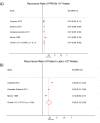Risk of recurrent spontaneous preterm birth: a systematic review and meta-analysis
- PMID: 28679674
- PMCID: PMC5734267
- DOI: 10.1136/bmjopen-2016-015402
Risk of recurrent spontaneous preterm birth: a systematic review and meta-analysis
Abstract
Objective: To determine the risk of recurrent spontaneous preterm birth (sPTB) following sPTB in singleton pregnancies.
Design: Systematic review and meta-analysis using random effects models.
Data sources: An electronic literature search was conducted in OVID Medline (1948-2017), Embase (1980-2017) and ClinicalTrials.gov (completed studies effective 2017), supplemented by hand-searching bibliographies of included studies, to find all studies with original data concerning recurrent sPTB.
Study eligibility criteria: Studies had to include women with at least one spontaneous preterm singleton live birth (<37 weeks) and at least one subsequent pregnancy resulting in a singleton live birth. The Newcastle-Ottawa Scale was used to assess study quality.
Results: Overall, 32 articles involving 55 197 women, met all inclusion criteria. Generally studies were well conducted and had a low risk of bias. The absolute risk of recurrent sPTB at <37 weeks' gestation was 30% (95% CI 27% to 34%). The risk of recurrence due to preterm premature rupture of membranes (PPROM) at <37 weeks gestation was 7% (95% CI 6% to 9%), while the risk of recurrence due to preterm labour (PTL) at <37 weeks gestation was 23% (95% CI 13% to 33%).
Conclusions: The risk of recurrent sPTB is high and is influenced by the underlying clinical pathway leading to the birth. This information is important for clinicians when discussing the recurrence risk of sPTB with their patients.
Keywords: preterm birth; preterm labor; preterm premature rupture of membranes; recurrence; systematic review.
© Article author(s) (or their employer(s) unless otherwise stated in the text of the article) 2017. All rights reserved. No commercial use is permitted unless otherwise expressly granted.
Conflict of interest statement
Competing interests: None declared.
Figures



References
-
- Dimes M. PMNCH, save the Children, WHO. the global action report on preterm birth. Geneva: World Health Organization, 2012.
-
- Lawn JE, Cousens S, Zupan J. Lancet Neonatal Survival Steering T. 4 million neonatal deaths: when? where? why? Lancet 2005;365:891–900. - PubMed
Publication types
MeSH terms
Supplementary concepts
Grants and funding
LinkOut - more resources
Full Text Sources
Other Literature Sources
Miscellaneous
